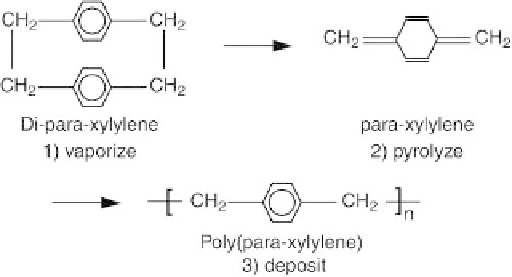Biomedical Engineering Reference
In-Depth Information
surface layers. However, they can significantly contrib-
ute (either positively or negatively) to the bioresponse
to the surface.
deposition, and polymerization of the monomer, di-
para
-
xylylene (DPX), according to the following reaction:
Conversion coatings
Conversion coatings modify the surface of a metal into
a dense oxide-rich layer that imparts corrosion pro-
tection, enhanced adhesivity, altered appearance (e.g.,
color) and sometimes lubricity to the metal. For exam-
ple, steel is frequently phosphated (treated with phos-
phoric acid) or chromated (with chromic acid).
Aluminum is electrochemically anodized in chromic,
oxalic, or sulfuric acid electrolytes. Electrochemical an-
odization may also be useful for surface-modifying tita-
nium
The DPX monomer is vaporized at 175
C and 1 torr,
pyrolyzed at 700
C and 0.5 torr, and finally deposited on
a substrate at 25
C and 0.1 torr. The coating has excellent
electrical insulation and moisture barrier properties and
has been used for protection of implant electrodes (Loeb
et al.,
1977b; Nichols
et al.,
1984) and implanted elec-
tronic circuitry (Spivack and Ferrante, 1969). Recently,
a parylene coating has been used on stainless steel car-
diovascular stents between the metal and a drug-eluting
polymer layer.
and
Ti-Al
alloys
(Bardos,
1990;
Kasemo
and
Lausmaa, 1985).
The conversion of metallic surfaces to ''oxide-like,''
electrochemically passive states is a common practice
for base-metal alloy systems used as biomaterials.
Standard and recommended techniques have been
published (e.g., ASTM F4-86) and are relevant for most
musculoskeletal load-bearing surgical implant devices.
The background literature supporting these types of
surface passivation technologies has been summarized
(von Recum, 1986).
Base-metal alloy systems, in general, are subject to
electrochemical corrosion (M / M
þ
þ
e
) within saline
environments. The rate of this corrosion process is re-
duced 10
3
-10
6
times by the presence of a dense, uni-
form, minimally conductive, relatively inert oxide
surface. For many metallic devices, exposure to a mineral
acid (e.g., nitric acid in water) for times up to 30 minutes
will provide a passivated surface. Plasma-enhanced sur-
face passivation of metals, laser surface treatments, and
mechanical treatments (shot peening) can also impart
many of these characteristics to metallic systems.
The reason that many of these surface modifications
are called ''oxide-like'' is that the structure is complex,
including OH, H, and subgroups that may, or may not, be
crystalline. Since most passive surfaces are thin films
(5-500 nm) and are transparent or metallic in color, the
surface appears similar before and after passivation.
Further details on surfaces of this type can be found in
Sections 3.1.4 and 3.2.9.
Laser methods
Lasers can rapidly and specifically induce surface changes
in organic and inorganic materials (Picraux and Pope,
1984; Dekumbis, 1987; Chrisey
et al,
2003). The ad-
vantages of using lasers for such modification are the
precise control of the frequency of the light, the wide
range of frequencies available, the high energy density,
the ability to focus and raster the light, the possibilities
for using both heat and specific excitation to effect
change, and the ability to pulse the source and control
reaction time. Lasers commonly used for surface modi-
fication include ruby, neodymium: yttrium aluminum
garnet (Nd: YAG), argon, and CO
2
. Treatments are
pulsed (100 nsec to picoseconds pulse times) and con-
tinuous wave (CW), with interaction times often less
than 1 msec. Laser-induced surface alterations include
annealing, etching, deposition, and polymerization.
Polymers, metals, ceramics, and even tooth dentin have
been effectively surface modified using laser energy. The
major considerations in designing a laser surface treat-
ment include the absorption (coupling) between the laser
energy and the material, the penetration depth of the
laser energy into the material, the interfacial reflection
and scattering, and heating induced by the laser.
Parylene coating
Parylene (
para-
xylylene) coatings occupy a unique
niche in the surface modification literature because of
their wide application and the good quality of the
thin film coatings formed (Loeb
et al.
, 1977a; Nichols
et al.
, 1984). The deposition method is also unique
and involves the simultaneous evaporation, pyrolysis,
Patterning
Essentially all of the surface modification methods de-
scribed in this section can be applied to biomaterial










